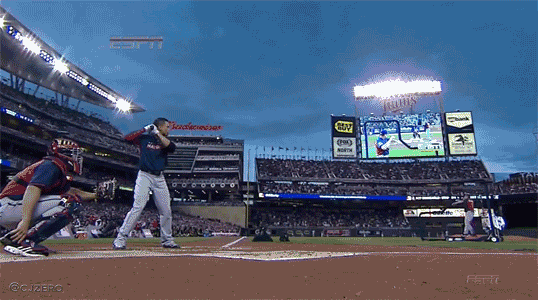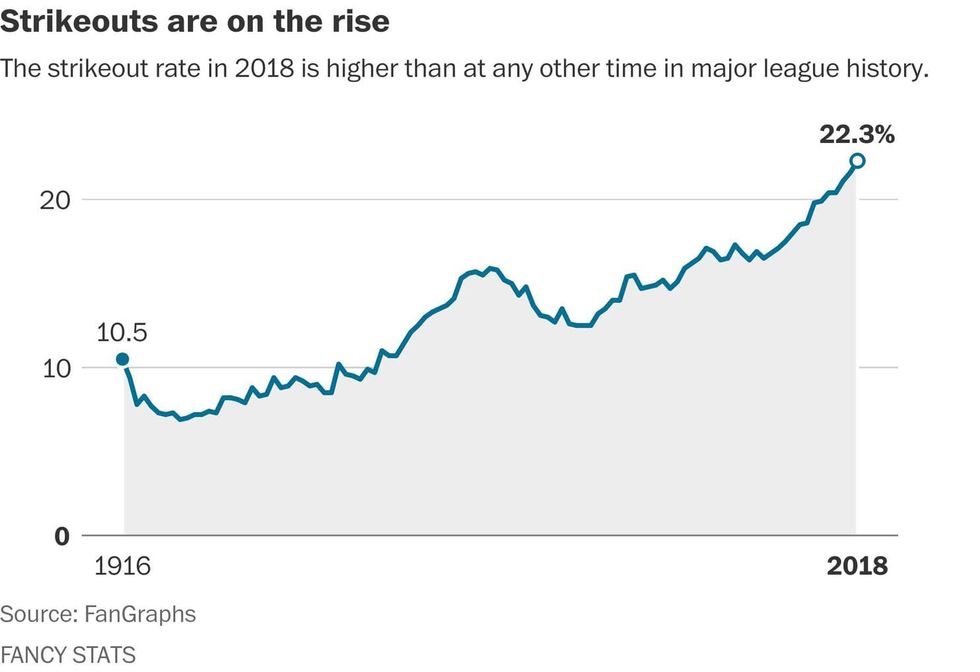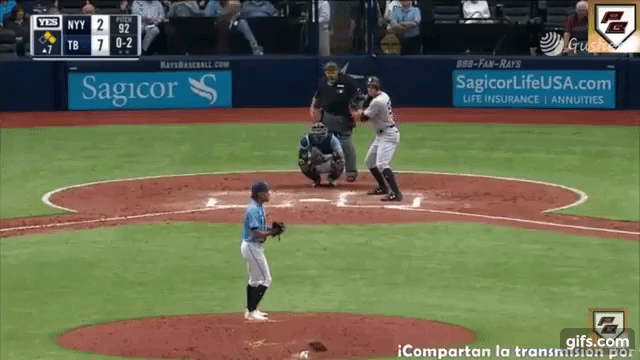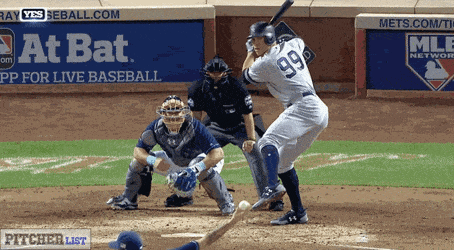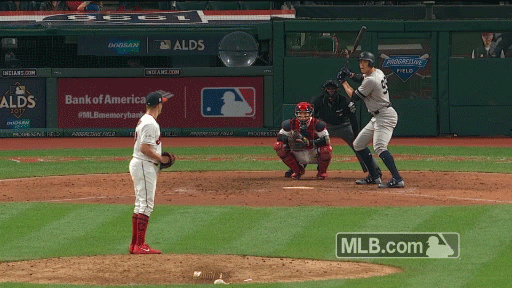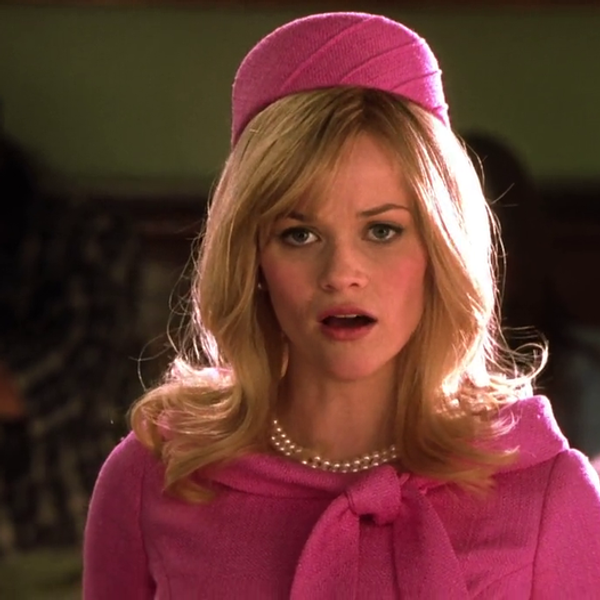The MLB 2017 season broke a lot of interesting, and contradicting, records. 6,105 home runs were blasted over the course of the year, shattering the record set back in 2000 of 5,693. Aaron Judge hit 52 of those in his first year in the league, passing Mark McGwire's 48 in 1987. What's interesting about the Yankees' rookie sensation is that while he was 2nd out of all the players in the MLB in homers, he was also 1st out of all of them in strikeouts with 208 (that's the seventh largest amount of strikeouts in one season in MLB history by the way) (Oh, and he struck out 28 more times in the post season). Giancarlo Stanton, who played for the Marlins last year, led the MLB in total home runs with 59, and was tied for 17th in the league for strikeouts (top 20 out of over 1,000 players).
Stanton and Judge, who became teammates after Stanton's December 11th trade to the Yankees, epitomize the trajectory and state of offense in baseball, and here's why:
Remember how I said the MLB broke its home run record in 2017- well, they also broke the league strike out record that same season with 40,105. This number surpassed the record previously set the year before, 38,982. The MLB set yet another record in 2017 with hitters being retired an average 21.6% of the time. Earlier in April, Washington Post journalist, Neil Greenberg published an article talking about the trend of increased strikeouts which has continued into the 2018 season, and in his report he notes that as of early April, 22.3% of all batters are retired (which is higher up than last year at this same point in the season). Major League hitters might be jacking out more 500+ foot dingers, but they're also racking up their fair share of K's in the process.
You'd think that overtime players would decrease their strike-out numbers as the technology-for and the science-of swinging mechanics advances. Instead, Ted Williams and his simplistic fundamentals of hitting would be disappointed to hear that the pressure to 'swing for the fences' has caused a noticeable shift in baseball statistics.
Yes, pitching and its transition towards a significantly less fastball-dominant strategy certainly aids in the explanation for these analytics. Red- Sox lefty, Chris Sale, threw for an impressive 308 strikeouts in 2017, with Cy Young Award winners Max Scherzer and Corey Kluber tossing 268 and 265 Ks respectively. However, it's important to point out, and Greenberg highlights this as a key component of the hitters' increased strike out numbers in his article as well: the hacks batters are taking against the pitchers' balls are completely missing more than ever.
For those of you who aren't as familiar with baseball terminology, when a batter's cut doesn't make contact with the ball at all, it's referred to as a 'whiff'. The whiff rate in the MLB has increased steadily, yet undeniably since 2006 (as seen in the chart below, curtesy of Neil Greenberg).
Season | Fastball usage | Whiff rate |
2006 | 59.7% | 8.1% |
2007 | 59.7% | 8.1% |
2008 | 59.7% | 8.2% |
2009 | 59.0% | 8.2% |
2010 | 57.3% | 8.1% |
2011 | 56.4% | 8.3% |
2012 | 55.9% | 8.7% |
2013 | 56.4% | 8.8% |
2014 | 56.4% | 8.9% |
2015 | 56.7% | 9.3% |
2016 | 55.6% | 9.5% |
2017 | 54.6% | 9.8% |
2018 | 55.2% | 10.6% |
Usually when a batter 'whiffs', it's because either the pitch's spin and break were down-right filthy, and or, the batter pulled their head off the ball. A big daddy hack, one meant for hitting homers and homers only, generally involves torquing the hips and coming through with the shoulders to such an extent that one loses the ability to watch the ball all the way through contact and extension. While it may seem like a rudimentary and trivial mechanic flaw, try hitting a professional baseball pitcher's curveball with your eyes closed, and I promise you'll catch my drift. Rotating the body through fast and hard during a swing is important, but it's also important to remember to keep it contained.
The MLB is having to compete with the swelling viewing ratings of the NBA and the always popular NFL. It's no secret that fans like to see bombs, and often times the players who go-yard more frequently than others, also develop larger fan-bases (attracting a more populated TV audience). Athletes are now being groomed earlier and more vehemently to swing for the fences because hey, that's where the game's going, right? However, because hitters today have developed such long-ball oriented mechanics, and pitchers have started to utilize the spin pitches in their repertoire more often and effectively, batters seem to struggle more with movement than velocity.
These power hitters rely on high launch angles from the up-and-coming 'rotational' swing in baseball that is designed to blast bombs all day long....off of fat pitches. Aaron Judge hit a juggernaut of 513 feet in the 2017 HR Derby (the longest of the night) with a launch angle of 35 degrees, but off of a meatball down the middle. These monster numbers and visuals offer high appeal to players and coaches who are looking to improve power statistcs quickly, but you've got to look at the whole picture.
This is a graph of Aaron Judge's 'heat map' for hitting (Baseball Prospects US). Essentially it diagrams which pitch locations he produces the most power from.
Not surprisingly, he likes thing down the pipe, and towards the lower hemisphere of the strike-zone where his upwards-trajectory swing (think of "dropping your hands" from rec-ball) can meet the ball at contact. Judge suffered a 37-game strikeout streak (record-breaking, of course) in 2017 following the All-Star Break, more impact-fully, the Home-Run Derby. Before the break, the rookie led the league in OPS and slugging percentage and had already rattled off 30 of his 52 dingers. After the Home-Run Derby, Judge seemed like a totally different player.
You see, he came off of a night where all he had to do was 'swing for the fences' at pitches right in the black and dark-red sections of that heat map, and transitioned to actually having to face real pitching with movements and unpredictable locations. Judges whiffs per swing ratio in the 2017 season were as follow: four-seamers (26.4% to 27.8%), sinkers (20.0% to 32.5%), sliders (46.1% to 67.2%), curves (51.9% to 554.6%) and changeups (40.7% to 47.6%).
Notice how the farther the pitch strays from a normal the fastball, the more he struggles to hit it (Jay Jaffe). With where the pitching style of baseball is moving towards, hitters like Judge are going to start having to figure out how to adjust their swings for breaking balls.
The rotational swing that Judge and his teammate Stanton have both adapted certainly improves distance and height...when the ball is hit. Otherwise, it leaves batters struggling to read and connect with outside or curving pitches, and instead favors pulling inside or red-zone pitches into the left-field stands. And if you, as a hitter, know that your game plan is to hit homers off of perfect pitches (or horrible pitches if you're on the defensive side of the at-bat), then you're also going to take a lot of pitches for strikes that you might otherwise try to poke into a gap somewhere for a base-hit.
Only 63 of Judge's 208 regular season strike outs were backwards K's, but that doesn't do justice to the amount of called-strikes that he and a lot power hitters across the league take, leaving them with 0-1, 0-2, or 1-2 counts. And who could blame them? Their swing is designed for a small section of the strike zone, so that's what they're going to wait to see. Wait for your exact pitch, or don't swing at all. All or nothing. That's baseball nowadays, folks
It's still too early in the 2018 season to really project what hitters like Stanton's or Judge's stats will be like come October, but as of right now, Stanton is tied for second in the MLB for strikeouts with 29 (out of 66 at bats as of April 18th) and he only has 3 home runs. Judge is looking better, tied for 41st with 18 Ks, and 4 HRs. However, it's not too early to recognize that baseball is undergoing a major change in the dynamic of the game.
Even though it's only April, more than a third of all plate appearances for all batters in the MLB have resulted in either a strikeout, walk, or home-run. I suspect this trend will only increase even more drastically as fans continue to demand long-balls and hitters continue to satisfy their needs. The importance of batting average has been replaced by the HR category, and pitchers are going to continue to re-calibrate their craft to respond, resulting in- you guessed it, more batters shaking their head, walking back to the bench empty-handed and disappointed.
Maybe it's about the fame and clout associated with round-trippers. Maybe players just don't want to run the bases anymore. Either way, baseball has changed, whether it be for better or for worse, and it'll be interesting to see where the sport goes next.


